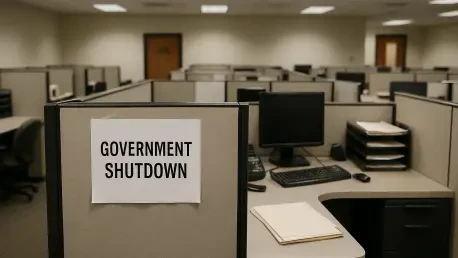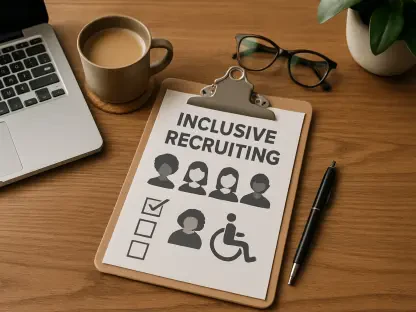When the U.S. federal government grinds to a halt due to Congress’s failure to pass a funding bill, the shockwaves reverberate far beyond political corridors, striking at the heart of human resources (HR) operations with immediate and profound consequences that challenge even the most prepared departments. For HR professionals tasked with managing compliance, employee well-being, and organizational stability, a shutdown transforms routine processes into a maze of uncertainty and disruption. Federal workers face furloughs, private employers grapple with delayed approvals, and critical systems become inaccessible, leaving HR teams to navigate uncharted territory. The ripple effects touch everything from payroll adjustments to morale management, posing challenges that test even the most prepared departments. This exploration delves into the multifaceted impacts of such an event on HR, uncovering how agency interruptions, compliance risks, and employee concerns converge to create a complex crisis, while highlighting the urgent need for resilience and adaptability in the face of political gridlock.
Federal Agency Disruptions and Their Ripple Effects
The most immediate consequence of a government shutdown is the paralysis of key federal agencies integral to HR functions, creating a cascade of operational hurdles. Agencies like the Department of Labor (DOL), Equal Employment Opportunity Commission (EEOC), and National Labor Relations Board (NLRB) often operate with drastically reduced staff or cease non-essential activities entirely. This means wage and hour enforcement stalls, discrimination investigations are put on hold, and union-related processes come to a standstill. Systems such as E-Verify, managed by the Department of Homeland Security (DHS), become unavailable, leaving employers unable to verify employment eligibility in real time. Despite this, HR teams must continue to complete mandatory documentation like Form I-9, adhering to compliance standards without the benefit of federal support. The sudden halt of these services disrupts daily workflows, forcing HR professionals to seek workarounds while bracing for the inevitable backlog once operations resume.
Beyond the immediate shutdown of services, the broader implications for HR departments become evident as inter-agency dependencies unravel. For instance, while U.S. Citizenship and Immigration Services (USCIS) may sustain limited operations due to its fee-based funding model, related processes like foreign labor certification applications overseen by the DOL face significant delays. This bottleneck directly impacts visa filings for nonimmigrant workers, stalling hiring plans for organizations reliant on global talent. Employers are left in a precarious position, unable to move forward with onboarding or resolve pending cases, while still facing legal obligations to maintain accurate records. The disparity in how agencies weather a shutdown—some continuing essential functions while others shut down completely—adds a layer of unpredictability, requiring HR teams to stay informed on agency-specific updates and adjust strategies accordingly to mitigate risks.
Immigration Processes and Workforce Verification Challenges
A government shutdown throws immigration-related HR tasks into disarray, creating delays that can derail hiring timelines and compliance efforts. Even though USCIS often continues limited operations thanks to its funding structure, the interconnected nature of immigration processes means that disruptions elsewhere, such as the DOL’s halt on processing foreign labor certification applications, slow down critical visa filings. Nonimmigrant workers awaiting approvals face prolonged uncertainty, which in turn affects employers planning to fill key roles. HR departments must manage these delays without clear timelines for resolution, balancing the need to maintain compliance with the frustration of stalled progress. The inability to access federal support during this period amplifies the challenge, often leaving organizations to navigate complex immigration rules without guidance.
Compounding the issue is the complete inaccessibility of tools like E-Verify during a shutdown, a system essential for confirming employment eligibility. Employers onboarding new hires find themselves unable to verify status in real time, yet they remain legally obligated to complete forms like I-9 within strict deadlines. This creates a compliance conundrum—HR teams must document everything accurately while lacking the means to confirm details, risking penalties if errors are later identified. Legal experts advise continuing to adhere to existing requirements and preparing for a surge of verification requests once systems are back online. The uncertainty surrounding how long the shutdown might last adds pressure, as delayed verifications can disrupt workforce planning and leave employees in limbo, highlighting the critical need for contingency plans in HR operations.
Operational Strains on HR Departments
The operational challenges a shutdown imposes on HR departments extend well beyond specific agency disruptions, affecting both public and private sectors in tangible ways. Managing furloughs for federal employees becomes a pressing concern, requiring careful coordination of payroll adjustments and communication to ensure affected workers understand their status. In the private sector, organizations dependent on federal contracts or approvals face similar disruptions, with projects delayed and financial stability threatened. Industry insights reveal that even a short shutdown can interrupt operations for a significant portion of organizations, with many seeing their annual financial targets jeopardized. HR professionals are thrust into a high-stakes balancing act, addressing immediate logistical needs while anticipating potential escalations if the situation persists.
Employee anxiety emerges as another critical operational challenge during these periods of uncertainty, demanding proactive engagement from HR teams. Federal workers and contractors, in particular, grapple with the fear of unpaid furloughs or even reductions in force, creating a tense atmosphere that can spill over to other sectors. HR departments must prioritize clear, empathetic communication to address concerns, provide updates, and offer support resources where possible. At the same time, internal processes like payroll adjustments or policy updates require meticulous attention under constrained timelines, often with limited access to federal guidance. The strain of managing these dual responsibilities—logistical and emotional—tests the resilience of HR teams, underscoring the importance of preparedness and adaptability in navigating the unpredictable landscape of a government shutdown.
Long-Term Backlogs and Compliance Pressures
One of the most enduring impacts of a government shutdown is the backlog of cases and processes that pile up at federal agencies, creating delays that linger long after operations resume. Legal advisors caution that suspended investigations at agencies like the EEOC, covering discrimination charges, and the NLRB, handling union petitions, could result in processing delays stretching over months. Employers awaiting resolutions on critical matters face extended uncertainty, complicating HR planning and risk management. Even as HR teams work to maintain compliance during the shutdown, the looming backlog means that the return to normalcy will not be immediate, requiring patience and strategic foresight to handle the eventual influx of pending cases and inquiries.
Compliance pressures further intensify as HR departments must uphold legal obligations despite the absence of federal systems and support. For example, completing Form I-9 for new hires remains mandatory, even when E-Verify is offline, placing the burden on employers to ensure accuracy without real-time validation. Failure to meet these requirements can lead to penalties once oversight resumes, adding a layer of risk to already strained operations. Experts recommend documenting all actions meticulously and preparing for a surge in workload post-shutdown, as agencies scramble to address accumulated cases. This dual challenge of maintaining standards during a shutdown and bracing for delayed resolutions afterward highlights the need for robust internal processes and a proactive approach to compliance within HR functions.
Human Toll on Employee Morale and Economic Stability
The human dimension of a government shutdown weighs heavily on HR, as employee morale takes a significant hit amid financial and professional uncertainty. Federal employees and contractors face the stark reality of unpaid furloughs or potential layoffs, fostering a climate of stress that can erode trust and productivity. This anxiety often extends to private sector workers whose livelihoods depend on federal contracts or timely approvals, creating a broader ripple effect across industries. HR professionals find themselves on the front lines, tasked with addressing these emotional challenges through transparent communication and support mechanisms, while simultaneously managing their own operational constraints. The psychological burden of a shutdown thus becomes a critical concern for maintaining workforce stability.
Economically, the shutdown’s impact on employees reverberates through communities, amplifying the stakes for HR departments. Federal workers without paychecks struggle to meet basic needs, while contractors and dependent businesses face cascading financial strain. This socioeconomic fallout places additional pressure on HR to advocate for affected employees, whether through temporary assistance programs or policy adjustments. The challenge lies in balancing these human-centric responsibilities with the logistical demands of a disrupted workplace, often without clear guidance on when relief might come. HR teams must therefore adopt a compassionate yet pragmatic approach, ensuring that the focus on employee well-being remains a priority even as broader systemic issues persist, highlighting the interconnectedness of individual and organizational health.
Advocating for Stability and Systemic Change
Industry leaders, including prominent voices from the Society for Human Resource Management (SHRM), have consistently urged Congress and the administration to resolve government shutdowns with urgency, emphasizing the profound disruptions they cause. The argument centers on the need for stability and certainty, not just for federal workers but for families, employers, and entire economic ecosystems. A prolonged shutdown exacerbates administrative burdens and financial risks, with HR departments bearing much of the brunt as they scramble to maintain operations. This collective call to action underscores a broader frustration with avoidable political gridlock, pushing for solutions that prioritize continuity over disruption and highlighting the critical role of governance in supporting workplace efficiency.
Looking ahead, the advocacy for systemic change reveals a deeper need for resilient frameworks within HR to withstand such crises. Experts suggest that organizations should develop contingency plans, such as alternative verification processes or enhanced employee support systems, to mitigate future impacts. HR professionals are encouraged to stay informed on legislative developments and agency statuses, ensuring they can adapt swiftly to changing circumstances. The emphasis on proactive preparation reflects a growing recognition that shutdowns, while unpredictable, are not entirely unforeseen, and sustained advocacy for stable funding mechanisms could prevent recurrence. This forward-thinking approach offers a pathway to lessen the toll on HR operations, reinforcing the importance of both immediate action and long-term reform.









